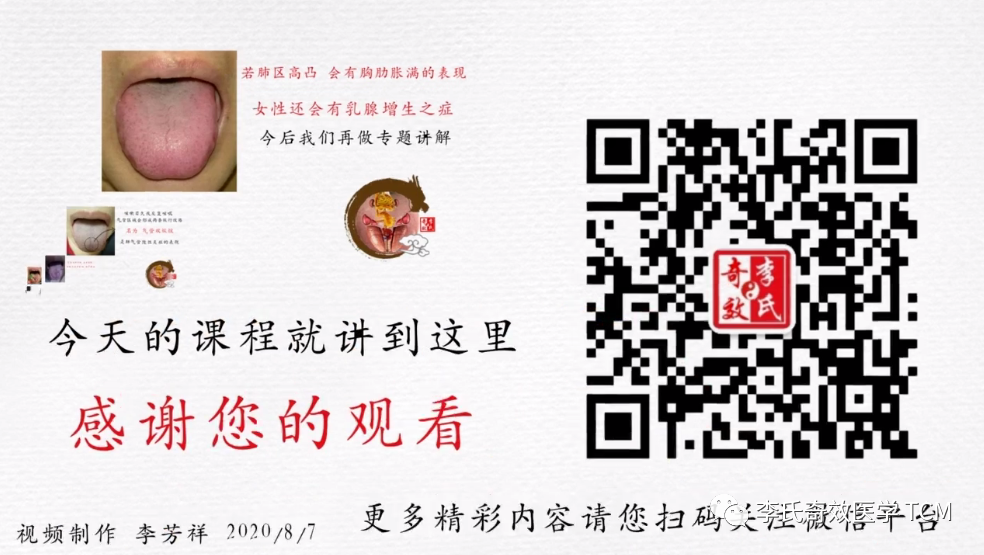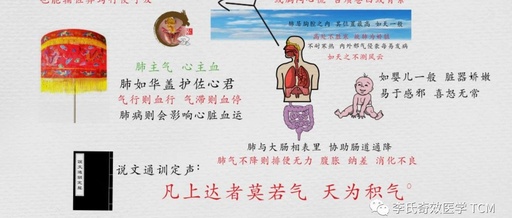Remarkable Tongue Diagnosis
Remarkable Tongue Diagnosis
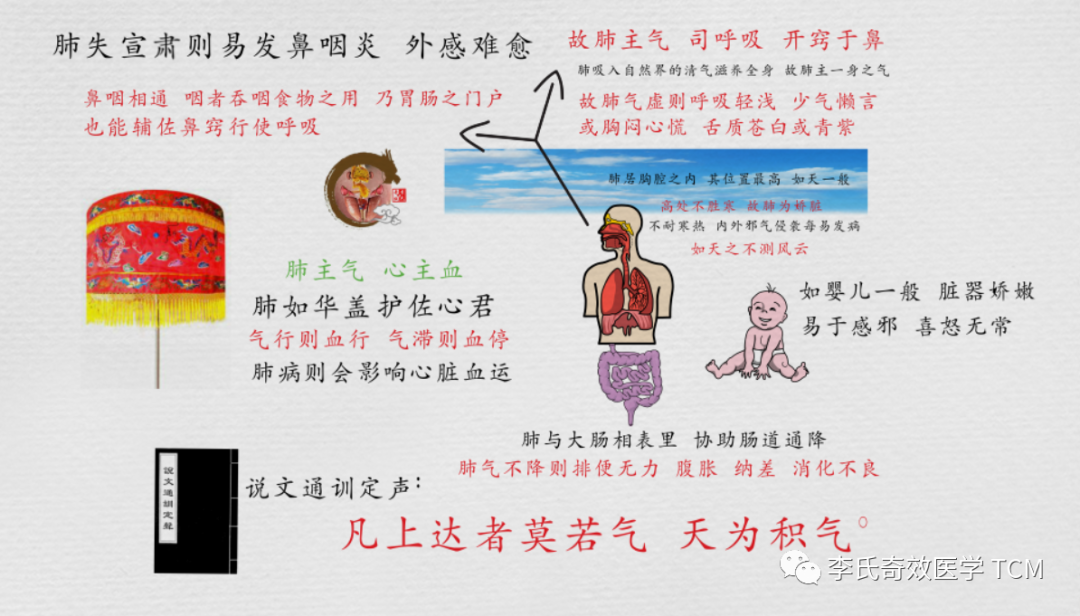 Lungs reside within the thoracic cavity, positioned at the highest point, akin to the sky. As the saying goes: “It is cold at high altitudes.” Therefore, the lungs are delicate organs, much like infants, with tender viscera that are easily invaded by external pathogens, exhibiting variable emotions, akin to unpredictable weather. According to the Shuowen Jiezi, “All that rises is Qi; heaven is the accumulation of Qi.” The lungs govern the Qi of the entire body and are responsible for respiration, opening to the nose. The lungs inhale the clear Qi from the natural world for the body to utilize, facilitating the combination of blood and oxygen to nourish the entire body. The lungs act as a canopy, shielding the heart from wind and rain, thus serving as an auxiliary organ, assisting the heart in circulating blood. It is often said: “When Qi flows, blood flows; when Qi stagnates, blood stagnates.” If the lung’s function of governing Qi is impaired, it will affect the heart’s function, leading to blood circulation disorders. This is similar to what Western medicine describes as pulmonary heart disease, where lung Qi stagnation results in elevated pressure in the pulmonary artery, leading to right heart failure. Mild cases may present with chest tightness, palpitations, fatigue, and a tongue that is bluish-purple or pale. The nasopharynx is interconnected, and the throat (yān) was historically written as “嚥,” meaning to swallow (yàn). Food enters the gastrointestinal tract through the “throat pass” for digestion, thus the throat serves as the gateway to the gastrointestinal tract. The connection between the throat and nasal passages aids in respiration, especially during severe nasal congestion, when mouth-breathing becomes necessary. Therefore, insufficient lung Qi may lead to shallow breathing, reluctance to speak, spontaneous sweating, aversion to wind, discomfort in the nasopharynx (nasal congestion, runny nose, cough, sore throat, etc.), susceptibility to colds, and difficulty in recovery. The lungs and large intestine are interrelated; lung Qi descends and assists the gastrointestinal tract in its downward movement. If lung Qi is deficient and does not descend, it may lead to abdominal distension, weak bowel movements, and poor appetite. Thus, when external pathogens invade the lungs, it is often accompanied by a lack of appetite.
Lungs reside within the thoracic cavity, positioned at the highest point, akin to the sky. As the saying goes: “It is cold at high altitudes.” Therefore, the lungs are delicate organs, much like infants, with tender viscera that are easily invaded by external pathogens, exhibiting variable emotions, akin to unpredictable weather. According to the Shuowen Jiezi, “All that rises is Qi; heaven is the accumulation of Qi.” The lungs govern the Qi of the entire body and are responsible for respiration, opening to the nose. The lungs inhale the clear Qi from the natural world for the body to utilize, facilitating the combination of blood and oxygen to nourish the entire body. The lungs act as a canopy, shielding the heart from wind and rain, thus serving as an auxiliary organ, assisting the heart in circulating blood. It is often said: “When Qi flows, blood flows; when Qi stagnates, blood stagnates.” If the lung’s function of governing Qi is impaired, it will affect the heart’s function, leading to blood circulation disorders. This is similar to what Western medicine describes as pulmonary heart disease, where lung Qi stagnation results in elevated pressure in the pulmonary artery, leading to right heart failure. Mild cases may present with chest tightness, palpitations, fatigue, and a tongue that is bluish-purple or pale. The nasopharynx is interconnected, and the throat (yān) was historically written as “嚥,” meaning to swallow (yàn). Food enters the gastrointestinal tract through the “throat pass” for digestion, thus the throat serves as the gateway to the gastrointestinal tract. The connection between the throat and nasal passages aids in respiration, especially during severe nasal congestion, when mouth-breathing becomes necessary. Therefore, insufficient lung Qi may lead to shallow breathing, reluctance to speak, spontaneous sweating, aversion to wind, discomfort in the nasopharynx (nasal congestion, runny nose, cough, sore throat, etc.), susceptibility to colds, and difficulty in recovery. The lungs and large intestine are interrelated; lung Qi descends and assists the gastrointestinal tract in its downward movement. If lung Qi is deficient and does not descend, it may lead to abdominal distension, weak bowel movements, and poor appetite. Thus, when external pathogens invade the lungs, it is often accompanied by a lack of appetite.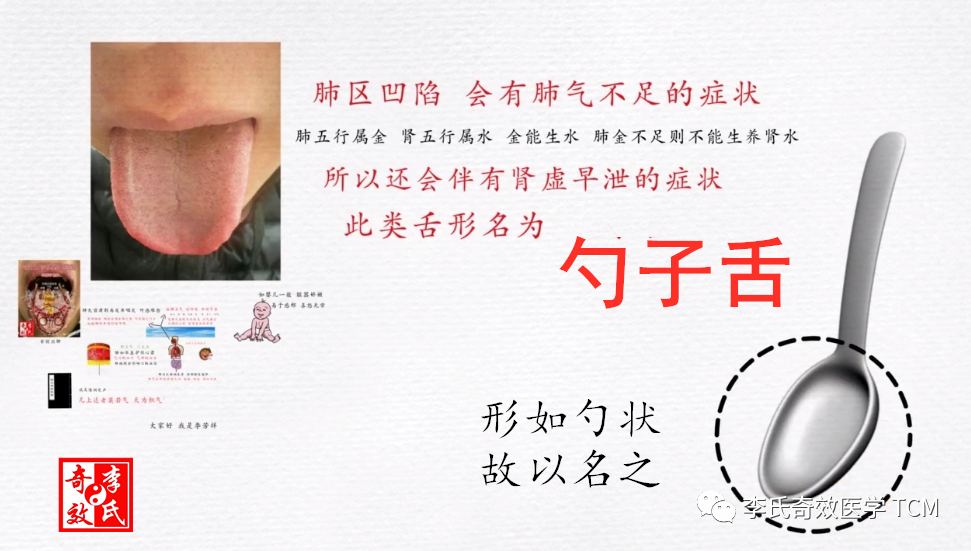 A concave area in the lung region of the tongue, or even a concavity in the middle and back of the tongue, indicates lung Qi deficiency and the deficiency of the spleen, lungs, and kidneys. The lungs belong to the metal element, while the kidneys belong to the water element. In the relationship of the five elements, metal generates water. If lung metal is deficient, it will be unable to nourish kidney water, leading to kidney water deficiency. Consequently, the tongue may also exhibit symptoms of kidney deficiency, and the lung metal’s inability to control liver wood results in water not nourishing wood, leading to excessive liver wood, which manifests as a raised edge of the tongue. The liver wood also overacts on the spleen and stomach, thus affecting digestion. This intermediate concavity, with raised sides or edges, resembles a spoon, hence the term “spoon tongue“.
A concave area in the lung region of the tongue, or even a concavity in the middle and back of the tongue, indicates lung Qi deficiency and the deficiency of the spleen, lungs, and kidneys. The lungs belong to the metal element, while the kidneys belong to the water element. In the relationship of the five elements, metal generates water. If lung metal is deficient, it will be unable to nourish kidney water, leading to kidney water deficiency. Consequently, the tongue may also exhibit symptoms of kidney deficiency, and the lung metal’s inability to control liver wood results in water not nourishing wood, leading to excessive liver wood, which manifests as a raised edge of the tongue. The liver wood also overacts on the spleen and stomach, thus affecting digestion. This intermediate concavity, with raised sides or edges, resembles a spoon, hence the term “spoon tongue“.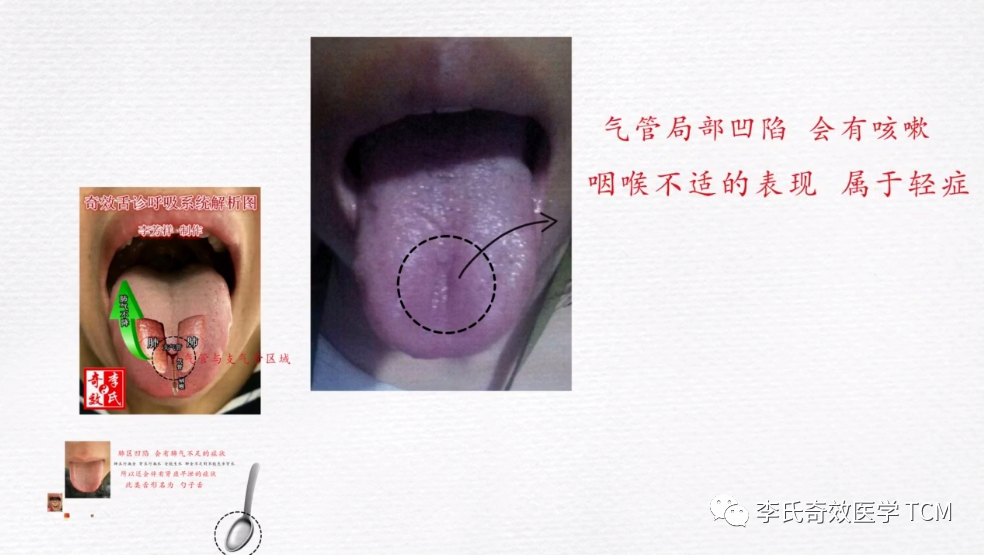 The area of the tongue corresponding to the lungs, near the midline groove, represents the trachea and bronchi. If there is an external cough persisting for many days, a small pit may form in this area, indicating throat discomfort and a tendency to cough.
The area of the tongue corresponding to the lungs, near the midline groove, represents the trachea and bronchi. If there is an external cough persisting for many days, a small pit may form in this area, indicating throat discomfort and a tendency to cough.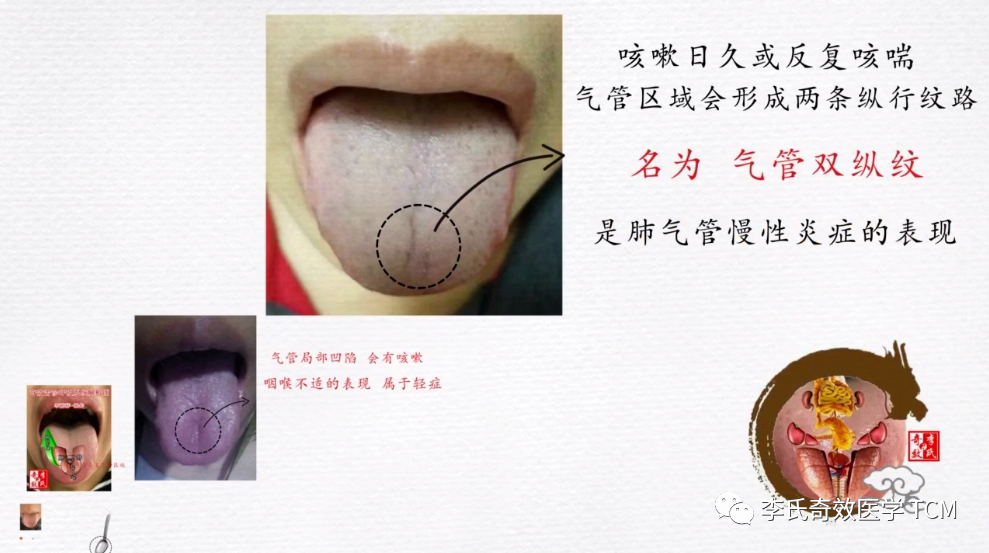 If coughing persists for a long time or recurs, two longitudinal lines may form in the trachea area, with very few cases showing only one line. These lines resemble the edges of the trachea and represent tracheal damage, indicating chronic inflammation of the trachea, hence termed “tracheal double longitudinal lines“.
If coughing persists for a long time or recurs, two longitudinal lines may form in the trachea area, with very few cases showing only one line. These lines resemble the edges of the trachea and represent tracheal damage, indicating chronic inflammation of the trachea, hence termed “tracheal double longitudinal lines“.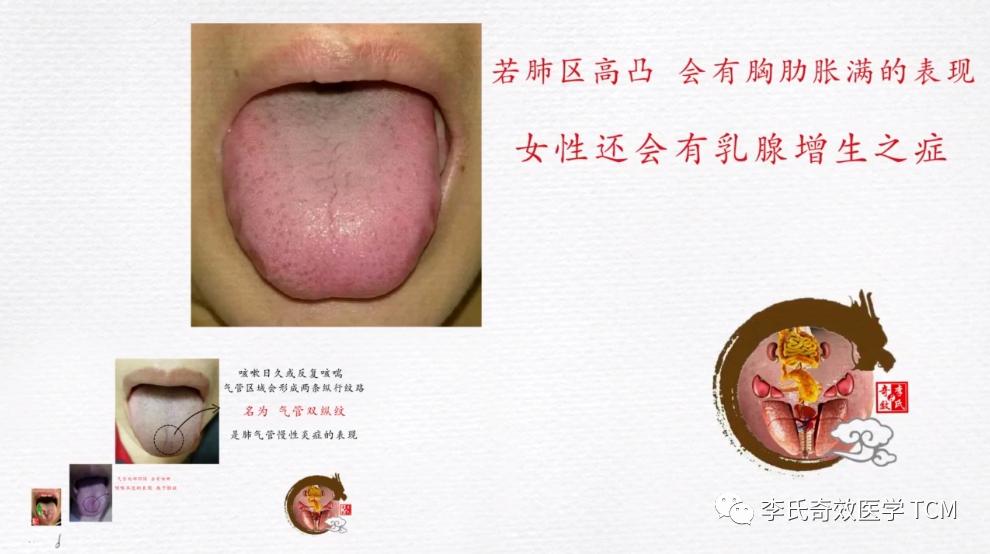 If the lung area and the front of the tongue are raised and thick, it indicates stagnation of lung Qi and liver Qi not being smooth, leading to a feeling of fullness in the chest and sides. Female patients may also experience breast hyperplasia and breast tenderness during menstruation. Based on the tongue’s lines, coating, and various signs, more detailed diagnoses can be made, such as the size and location of masses, as well as their benign or malignant nature. We will provide a more detailed explanation in future sessions.Today’s lesson ends here. Thank you for watching, and see you next time.
If the lung area and the front of the tongue are raised and thick, it indicates stagnation of lung Qi and liver Qi not being smooth, leading to a feeling of fullness in the chest and sides. Female patients may also experience breast hyperplasia and breast tenderness during menstruation. Based on the tongue’s lines, coating, and various signs, more detailed diagnoses can be made, such as the size and location of masses, as well as their benign or malignant nature. We will provide a more detailed explanation in future sessions.Today’s lesson ends here. Thank you for watching, and see you next time.